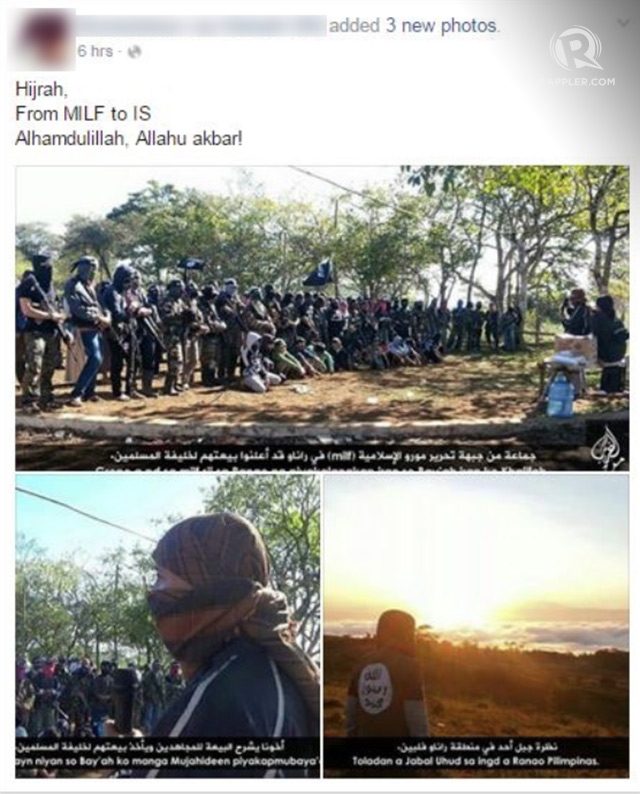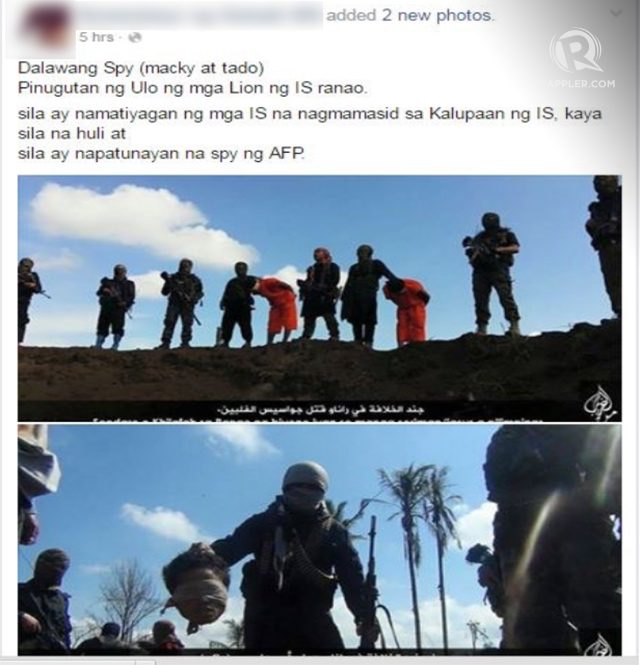SUMMARY
This is AI generated summarization, which may have errors. For context, always refer to the full article.

Although the government declared a state of lawlessness, authorities have released little concrete information about the explosion that killed at least 14 people in Davao City’s night market Friday, September 2, 2016.
On Saturday morning, September 3, radio station DZMM said the Abu Sayyaf claimed responsibility for the blast in an interview with a self-proclaimed spokesman for Al Harakatul Al Islamiyah, the formal name used by the Abu Sayyaf.
By the afternoon, however, allegedly that same man, Muammar Askali, alias Abu Ramie, told the Inquirer that it was carried out by an ally he called Daulat Ul Islamiya.
“They are doing this to sympathise (with) our group, and we are sending a message to President Rodrigo Duterte that all the Daulat throughout the country is not afraid of him,” said Askali.
So who could be behind the explosion? To answer this question, let’s look at the facts we know and provide some context.
Islamic Community
First, the name Daulat Ul Islamiyah is a slight variation of Jemaah Islamiyah, which literally means “Islamic Community.” From the late 90s to 2005, Jemaah Islamiyah acted like al-Qaeda’s arm in Southeast Asia, gaining global notoriety with the Bali bombings in 2002, which killed more than 200 people.
The Abu Sayyaf was part of Jemaah Islamiyah and carried out a spate of bombings in the Philippines, including Southeast Asia’s worst maritime terrorist attack in 2004. It was blacklisted as a terrorist organization by numerous countries, including the Australia, Canada, Indonesia, Malaysia, the Philippines, and the US for bombings, kidnappings and beheadings.
During its heyday, authorities said the Abu Sayyaf had up to 1,200 members which after more than a decade’s presence of US troops, went down to as low as 240. Filipino officials say they estimate about 400 members today.
President Rodrigo Duterte ordered this crackdown after the beheading of a Filipino too poor to pay ransom. That follows 2 high-profile beheadings of Canadians held for ransom.
According to Rappler’s sources, there are about 8,000 troops chasing the Abu Sayyaf today in Jolo, Sulu – or about 20 soldiers for every Abu Sayyaf member, but the ground war is never this easy in this complicated terrain.
Abu Sayyaf and ISIS
It’s important to recognize that the most senior ideological leader of the Abu Sayyaf, Isnilon Hapilon, has pledged allegiance to the leader of the Islamic State or ISIS. At least 4 other groups in the Philippines have done the same and named Hapilon as their emir, one of the final steps for ISIS to declare a wilayat or province. (READ: Experts warn PH: Don’t underestimate ISIS)
Initial intelligence reports confirmed Sunday by the police said the explosion was caused by an IED, an improvised explosive device made from a mortar round.
The Sulu-based Abu Sayyaf tend to use ammonium nitrate for its explosives. A mortar round IED is closer to the signature bombs of two Abu Sayyaf allies who have pledged allegiance to ISIS: Ansar al-Khalifa, also known as AKP or Ansar Khalifa Philippines, based in southern Mindanao; and the Maute group in central Mindanao, also known as Daulah Islamiyah.
Both these groups evolved significantly since the time they worked with Jemaah Islamiyah.
AKP and Indonesia
AKP is headed by Mohammad Jafar Maguid, more commonly known as Commander Tokboy, allegedly a former commander of the Moro Islamic Liberation Front (MILF) 105th Base Command. (READ: Two ISIS-allied militants killed in Philippines)
Tokboy was trained by key JI leaders, including Malaysian Zulkifli bin Hir, better known as Marwan, the high profile target of the Mamasapano tragedy that derailed the peace talks. (READ: Marwan’s ties that bind: From family to global terrorism)
AKP under Tokboy has a direct link to Indonesian groups, especially MIT, Mujihidin Indonesia Timur, led by an Indonesian who trained in the Philippines, Santoso.
Indonesian intelligence sources said they were investigating the flow of explosive materials from the Philippines to Indonesia after the January 14, 2016 Jakarta bombings.
In July, 2016, Indonesian forces killed Santoso, dubbed the “symbolic heart” of the Indonesian jihadi movement. Some warned that his comrades may join the Abu Sayyaf. (READ: After death of Indonesia’s top terrorist, comrades ‘may join Abu Sayyaf’)
AKP pledged allegiance to ISIS in a YouTube video in 2015, and is largely believed by experts to be one of the groups behind another video threatening the November, 2015 APEC Summit in Manila and later globally distributed by ISIS propaganda sites. (READ: ISIS’ global ambitions and plans for Southeast Asia)
ISIS claims Maute jail break
The Maute group, which also calls itself Daulah Islamiyah, has carried out bombings and kidnappings. It carries the black flag and insignia of ISIS, and has been very active this year.
From February 20 to March 1, 2016, the group, which pledged allegiance to ISIS, attacked a military camp and established 3 major strongholds, essentially displacing nearly 30,000 people until troops regained control of the town of Butig in Lanao del Sur. During that time, the group beheaded a soldier. It took 10 days for the military to regain control.
On April 21, 2016, a Facebook account posted two photos showing the Maute group beheading two of six sawmill workers kidnapped from Butig. They released four of the hostages six days after their kidnapping, but chose to behead the two because they were allegedly military informants.
The two beheaded were forced to wear orange jumpsuits, much like ISIS public executions. The post says, “Two spies beheaded by the Lions of IS ranao.”

Finally, just last week on August 29, an ISIS propaganda arm, the Amaq news agency, claimed that ISIS was behind a prison raid at the Lanao del Sur jail in Marawi.
“Fighters from Islamic State stormed a prison in Marawi City in Philippines on Saturday, south of the country, and were able to free thirty prisoners and seizing weapons,” wrote Amaq news agency.
“Thirty fighters carried out the attack and were able to release 30 detainees, including fighters from the Islamic State and their wives. The fighters of the attack and all the detainees, who were freed, arrived to safe places without injuries,” it stated.
Those arrested were caught with homemade mortars, which they told interrogators, were to be used in bombing missions in Iligan and Cagayan de Oro.
In its report, the BBC said no shots were fired during the prison break, and that a military source said “the men had been allowed to escape.”
A military report obtained by Rappler states, “recruits of the Maute group were largely drawn from the MILF ranks, particularly disgruntled factions prompted by the failures in the Bangsamoro Basic Law or close associates and blood relatives.”
Evolving landscape
These are only some of the possible groups behind the Davao bombing.
What happened to the terrorist networks in the Philippines is exactly what happened to al-Qaeda globally: authorities gouged out their top and middle rank leadership, but the ideology and cells continued to burrow and evolve.
Jemaah Islamiyah was an umbrella group that hijacked homegrown networks. Although the MILF turned away from global terrorism in 2005, other groups like the Abu Sayyaf, the Rajah Solaiman Movement, continued to push a terrorist agenda.
There are still other groups like the al-Khobar, another MILF extremist splinter group that turned to criminal activities like bus bombings in 2011. (Read: Philippines’ evolving terrorism threat)
What has happened to them today?
A clear evolution is the clarion call of the Islamic State, which has its own Southeast Asian battallion in Syria called Khatibah Nusantara. (READ: ISIS and Jakarta attacks: What we need to know)
Part of the problem is that the strategy of the Aquino administration largely centered on denial. This is despite the June, 2016 call of a Malaysian jihadist in Syria, Mohd Rafi Udin, for ISIS followers to go to the Philippines, making it “the nucleus” in Southeast Asia. (READ: ISIS to followers in SEAsia: ‘Go to the Philippines‘)
This month, President Rodrigo Duterte became the first Filipino official to publicly acknowledge the threat of ISIS. (Read: Duterte: ISIS followers radicalizing Filipinos in Mindanao)
Finding those behind the Davao bombing will give us a further idea of how terrorist networks have evolved. – Rappler.com
Maria A. Ressa is the author of Seeds of Terror: An Eyewitness Account of Al-Qaeda’s Newest Center of Operations in Southeast Asia and 10 Days, 10 Years: From Bin Laden to Facebook.
Add a comment
How does this make you feel?
There are no comments yet. Add your comment to start the conversation.